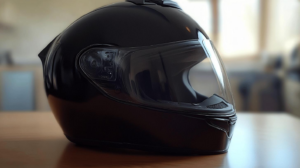How tight should a motorcycle helmet be for safety? It's a question that divides motorcyclists, with some insisting a snug fit is non-negotiable and others suggesting a bit more comfort.
But the stakes are high: an ill-fitting helmet not only jeopardizes your safety on the road but also your riding comfort. In this guide, we’ll explore the crucial role of fit in helmet effectiveness and how to achieve that perfect balance between snug and secure.
Understanding helmet safety ratings and the impact of size will arm you with the knowledge to ride safely and confidently.
Understanding the Importance of a Properly Fitting Motorcycle Helmet

A properly fitting motorcycle helmet is essential for ensuring rider safety. How tight should a helmet be for safety? A helmet should be snug enough to stay securely in place, but not so tight that it causes discomfort or pressure points.
DOT approval is tied to proper helmet fit, underscoring that a correctly sized helmet is critical for safety. An ill-fitting helmet, one that's too loose or too tight, can compromise protection in an accident. A snug fit ensures that the helmet's protective elements, such as the EPS liner, remain in the optimal position to absorb impact forces effectively.
Comfort plays a vital role in how a helmet affects riding performance. A helmet that fits well enhances concentration and reduces distractions. It should be comfortable enough for long rides, preventing headaches or pressure on the forehead.
This comfort supports stable vision and unobstructed hearing, both of which are important for maintaining focus on the road. A properly fitting helmet minimizes the need for adjustments while riding, allowing the rider to fully concentrate on their surroundings and the task at hand.
-
Ill-fitting helmets can lead to discomfort and headaches.
-
Improper fit may cause the helmet to shift during a ride, compromising safety.
-
A helmet that's too loose can impair vision by moving unexpectedly.
-
An overly tight helmet can cause pressure points, leading to pain.
-
Poor fit increases the risk of injury in an accident due to inadequate protection.
Steps to Measure Your Head for a Motorcycle Helmet

Accurate head measurement is the foundation of finding a helmet that fits correctly and provides the requisite protection. A helmet that's either too large or too small can significantly compromise safety and comfort. Therefore, it's crucial to measure your head precisely before relying on a motorcycle helmet sizing chart to determine the right size. This ensures that the helmet will sit securely without undue movement, maintaining optimal safety conditions in the event of impact.
-
Get a flexible tape measure: Use a cloth or soft tape measure, as it can easily contour to the shape of your head.
-
Measure the largest part of your head: Wrap the tape measure around your head, just above the eyebrows and ears, ensuring it encircles the widest area.
-
Take note of the measurement: Record the measurement in centimeters or inches, whichever your helmet manufacturer requires.
- Repeat for accuracy: It's wise to measure a couple of times to confirm consistency and ensure you have the correct measurement.
Once you've obtained your head measurement, consult the manufacturer's sizing chart to find the correct helmet size. These charts can vary significantly between brands, as each manufacturer may have unique sizing guidelines.
Typically, the chart will list head circumferences alongside corresponding helmet sizes. It's important to match your head measurement as closely as possible to the chart, bearing in mind that some brands might offer slightly different fits for the same size designation.
This step is paramount to converting your raw measurement into a practical helmet size that matches your specific needs.
Trying on a Helmet: Ensuring a Snug Yet Comfortable Fit

Wearing a motorcycle helmet for a minimum of 15 minutes is a crucial step in assessing its fit and comfort. This timeframe allows the rider to identify any pressure points or discomfort that might not be immediately apparent.
The helmet should feel snug, providing even pressure around the head without any tight spots that could lead to pain. It's important to ensure that the helmet does not move independently when you shake your head. If it shifts, the helmet might be too loose, compromising safety.
Attention to specific fit indicators is essential for ensuring the helmet provides optimal protection. Cheek pads should make gentle contact with the cheeks, offering support without causing discomfort. This contact helps stabilize the helmet, preventing it from moving excessively during a ride.
Additionally, the chin strap must be snug; it should hold the helmet securely in place without exerting excessive pressure on the throat. Adjustability is key, as different helmets offer various cheek pad thickness options to accommodate different facial structures.
| Feature | Ideal Fit |
|---|---|
| Cheek Pads | Gentle contact with cheeks, no excessive pressure |
| Chin Strap | Snug but not restrictive, allowing easy breathing |
| Helmet Movement | Minimal, should not move independently when shaking head |
| Overall Fit | Snug, even pressure around head, no tight spots |
Identifying Signs of an Ill-Fitting Helmet

Recognizing the signs of an ill-fitting helmet is crucial for ensuring both safety and comfort while riding. How can you tell if a motorcycle helmet is too tight? A helmet that's too tight can cause headaches due to excessive pressure on the forehead or scalp.
Conversely, how do you know if a helmet is too loose? A helmet that's too loose might shift during rides, leading to impaired vision and increased noise, which can distract the rider and compromise safety. Identifying these signs early helps prevent discomfort and ensures the helmet provides adequate protection in the event of an accident.
-
Headaches from pressure on the forehead or scalp
-
Excessive shifting or movement during rides
-
Gaps between the helmet and your head
-
Impaired vision due to helmet shifting
-
Increased noise from wind entering the helmet
-
General discomfort or need for constant adjustment during use
Adjusting Your Helmet for Optimal Fit and Comfort

Adjusting a motorcycle helmet to achieve an optimal fit is crucial for both safety and comfort. Customizing helmet fit involves several potential adjustments, primarily focused on internal components such as cheek pads and liners.
By fine-tuning these elements, riders can significantly enhance their helmet's comfort level without compromising safety. Adjusting helmet cheek pads, for instance, can address fit issues around the face, ensuring the helmet remains snug without causing pressure points.
-
Swap cheek pads of varying thickness to achieve a snug fit without discomfort.
-
Use adjustable chin straps to ensure the helmet sits correctly on the head.
-
Replace or add helmet liners to better conform to individual head shapes.
-
Consider helmets with interchangeable internal components for more flexibility.
-
Regularly reassess and adjust fit as padding compresses over time.
Professional assistance can be invaluable when adjusting helmet fit, especially if discomfort persists. Retailers or manufacturers often offer guidance and solutions for customizing helmet fit, such as providing alternative padding options.
It's crucial to avoid unsafe modifications, like altering the EPS liner or applying heat, as these can compromise the helmet's protective capabilities.
Adjustments can make a significant difference in how a helmet feels during a ride. For example, swapping cheek pads might alleviate excessive pressure on the cheeks, while adjusting the chin strap can prevent the helmet from shifting.
Ultimately, these modifications ensure the helmet remains securely in place, providing both comfort and protection, which enhances the overall riding experience.
Break-In Period and Long-Term Helmet Fit

The break-in period for a motorcycle helmet is crucial for achieving a comfortable and secure fit over time. How long is the break-in period for helmets? Typically, a breaking-in period can range from a week to a month. During this time, the helmet's interior padding compresses and conforms to the unique contours of the rider's head.
This process is necessary because a new helmet should initially fit slightly snug to ensure it remains secure without shifting during rides. As the helmet breaks in, the snugness should transition to a comfortable fit, enhancing both safety and comfort.
To ease into a new helmet, riders can follow specific break-in techniques. Start by wearing the helmet for short periods around the house to allow the padding to adjust gradually. This also helps identify any pressure points that might need attention.
It's advisable to wear the helmet for progressively longer durations, gradually increasing the time spent wearing it to help the materials conform without causing discomfort. This gradual approach prevents the development of pressure points that can cause headaches or discomfort.
Over time, the fit of a helmet can change due to the compression of the interior padding. How should you know when to reassess helmet size? If the helmet becomes noticeably loose, shifts easily, or no longer provides the snug fit it once did, it may be time to reassess its size.
Regular checks on helmet fit ensure ongoing safety and comfort. Adjustments or replacements may be necessary to maintain the helmet's protective effectiveness.
Final Words
Achieving the ideal fit for a motorcycle helmet is crucial for safety and comfort. Understanding how tight a motorcycle helmet should be involves recognizing the balance between snugness to prevent movement and comfort to avoid pressure points.
Proper measurements, thorough trials, and adjustments can enhance both safety ratings and overall riding experience. Continual attention to your helmet's fit ensures both protection and enjoyment. Embrace each ride with confidence, knowing your helmet is doing its job effectively.
FAQ
How tight should a motorcycle helmet be?
A motorcycle helmet should be snug without causing discomfort. It should not move independently of your head, and there should be no pressure points, particularly around the forehead and cheeks.
Is it better to size up or down a motorcycle helmet?
Choosing the smaller size is advisable if your measurement is between sizes. The helmet should fit snugly but comfortably without causing any pain or pressure points.
Should my chin touch my motorcycle helmet?
Your chin should not touch the helmet. The chin strap should be secure, ensuring the helmet doesn’t move excessively but doesn't press into the chin.
How snug should motorcycle helmets be on cheeks?
Cheek pads should make gentle contact with your cheeks without excessive pressure. When you wear the helmet, it should hold firmly but comfortably.
What are signs that my helmet doesn't fit properly?
An ill-fitting helmet may cause headaches, move excessively, create gaps, impair vision, or increase noise. Check comfort, especially on the forehead and around the chin.
How can I adjust my helmet for a better fit?
Adjustments can include swapping cheek pads, changing internal padding, or consulting with a retailer or manufacturer for professional adjustments. Avoid modifying the EPS liner.
Is there a break-in period for motorcycle helmets?
Yes, helmets generally "bed in" over time, conforming slightly to the head shape. An initially snug helmet may become more comfortable with regular use after a few weeks.

Ryan Thompson is a 35-year-old sport bike enthusiast known for his adventurous spirit. With years of weekend rides and exploring new roads, Ryan brings fresh insights and firsthand experience to ProtectiveGearz. His energetic approach and passion for the latest gear make him a trusted source for riders seeking up-to-date advice.



